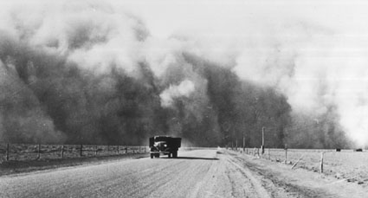- The Dust Bowl occurred in the 1930’s. The decade was called the “Dirty Thirties”. The worst years were 1930-31, 1934, 1936, and 1939-40. The states that were most effected were Texas, New Mexico, Colorado, Kansas, Oklahoma, and Nebraska.
- It was caused by a combination of bad farming methods, high winds, and drought. During WWI, the price of wheat soared as American farmers found new markets in Europe. Those markets dried up once European farmers got back on their feet, so American farmers plowed even more farmland to make up for lower prices with more quantity. This increased the damage to the grasslands of the Great Plains. New gas-powered tractors allowed for more efficient plowing, but the native grasses that anchored the soil were torn up, leaving the topsoil loose and liable to be blown away. The coincidence of a decade with below average rain and above average winds spelled disaster. By 1934, 34 million acres of farmland were useless.
- The term came from a newspaper article by Robert Geiger in 1935. He said: “Three little words achingly familiar on a Western farmer’s tongue rule life in the dust bowl – if it rains.”
- Geiger was writing about the worst dust storm of the decade. It started on April 14, 1935. The “black blizzard” reached two miles high. It traveled all the way to the east coast. The Statue of Liberty and the Capitol Building were obscured. Ships in the Atlantic got a coating of dirt.
- As though things were not bad enough, the region was hit by a series of locust plagues and floods of ravenous jackrabbits. It was estimated that at their worst, 23,000 locusts could be found per acre. Communities organized “rabbit hunts” where rabbits were herded into pins and then killed with clubs and baseball bats.
- Hundreds of people, mostly the elderly and children, died for dust pneumonia, also known as the “brown plague”.
- The storms created high amounts of static electricity. If you shook hands with someone, you might both be knocked to the ground.
- One folk remedy was to kill snakes and hang them belly-up on fences. Some rain makers offered to bring rain by firing rockets with dynamite and nitroglycerine to explode in the sky.
- It is estimated that up to 35 million people migrated from the area. This was actually only ¼ of the residents, so most people toughed it out. The ones who left were collectively known as “okies” although most did not come from Oklahoma. It is a myth that they all went to California. Most simply moved to a neighboring state.
- It got so bad at times, that cars had to use their lights in the middle of the day and street lights would be put on. Kids wore dust masks to school, if their school was still open – many closed. If you got caught outside during a dust storm, you might have a hard time finding your house. Dust drifts covered roads.
https://www.history.com/news/10-things-you-may-not-know-about-the-dust-bowl
https://www.history.com/topics/great-depression/dust-bowl

0 Comments